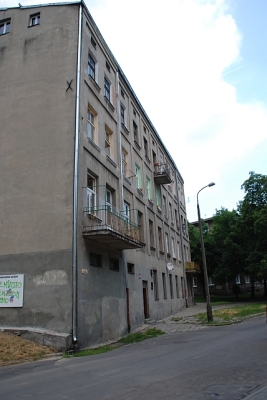Little remains on this small street from the ghetto era. There were many buildings on Sw. Jakuba Street at that time, but only one still exists.
From the beginnings of the ghetto until May 1, 1940, the tenement building at 10 Sw. Jakuba St. was an assembly point for the Jewish people who had to move to the Baluty area from other districts of Lodz. Here, they were allotted apartments. Later, one of the central soup kitchens was located on that site.
Starting in October 1941, this was the housing site for Jews brought in from Austria and Czechoslovakia, most predominantly from Vienna and Prague, called collectives "Vienna II" and "Prague V" (The Roman numerals indicate the transport number.)
In mid-May 1942, after many of the Jews from outside Poland were deported to the death camp at Chelmno-nad-Nerem, the building housed the tailoring department and the Central Depot for Raw Materials.
 The first labor department, which was the tailoring department, was established in the building at 8 Sw. Jakuba St. as early as June 15, 1940, and a Christian prayer hall was organized in the neighboring building at 6 Sw. Jakuba in December 1941.
The first labor department, which was the tailoring department, was established in the building at 8 Sw. Jakuba St. as early as June 15, 1940, and a Christian prayer hall was organized in the neighboring building at 6 Sw. Jakuba in December 1941.
In August 1944, a camp was established in a former factory at 16 Sw. Jakuba for the people left to clean up after the final liquidation of the ghetto. They had to prepare machines and objects remaining from the labor departments for transport to the Reich.
The majority of the 800 people that remained behind lived to see the Soviet Army enter Lodz. The building was taken down after the war.
On Christmas Eve, Mr. Chairman gave his permission to conduct Christian services, and allotted a two-room modern apartment at 6 Jakuba St. for this purpose. The services are held separately for Catholics and Protestants.
The Catholic service, attended by approximately 40 people, was conducted by a woman, a graduate in theological studies, who arrived in the ghetto recently from Germany. Reportedly, there are two Catholic priests among the arrivals. The Protestant service was conducted by a pastor.
The Chronicle of the Lodz Ghetto, December 26-28, 1941, Vol. 1, p. 339.
The central depot of raw materials and a workshop are to be established in a large building at 10 Jakuba St., where the tailoring department was located previously.
The raw materials are not the materials supplied from the outside of the ghetto and destined for production on the [German] authorities' orders, but the raw materials resources possessed by the ghetto itself, and gathered, for instance, in the Bank, the Purchase Headquarters, the Tailoring Headquarters and in numerous departments. The above-mentioned workshop will produce various kinds of goods from those materials; mainly garments, underwear, leather straps and corsets. The entire production will be exported outside of the ghetto. At present, the central depot and the workshops employ already 1,000 workers.
The Chronicle of the Lodz Ghetto, November 12, 1942, Vol. 2, p. 365.
I haven't got any direct or indirect reports about the camp at 16 Jakuba St. Not so long ago we received some sugar from there. Someone has even announced his or her visit. We don't know why the visit didn't come off. .
Jakub Poznanski, September 13, 1944, p. 217.

 Home
Home
